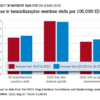Socioeconomic impact
The effects of the opioid epidemic are felt in all areas of the United States, especially in the health care industry. Emergency department visits are mounting while billions of dollars are spent on medical care for those addicted to opioids. Additionally, the socioeconomic effects of this crisis contribute to increasing depression, anxiety, missed days of work or school, unemployment, drop-out rates, and loss of productivity among those addicted to opioids. Also, the epidemic is adversely affecting families, leading to increased divorce rates, single parent families, and child abuse and neglect. By creating strategies and protocols for medical staff, patients, and families affected by opioid use, addiction, or overdose, hospitalists can have a positive influence on patients’ lives and ultimately the opioid epidemic.
Dr. Kasarla is a hospitalist with Apogee Physicians at Parkway Surgical & Cardiovascular Hospital in Fort Worth, Tex. He also works for Texas Health Physicians Group at Texas Health Harris Methodist Hospital and Texas Health Harris Methodist Hospital Southwest in Fort Worth, as well as at Texas Health Harris Methodist Hospital in Azle, Tex.
You can contact him at [email protected] or [email protected].
References
1. Understanding the Epidemic: Drug overdose deaths in the United States continue to increase in 2015. Accessed Sept. 11, 2017.
2. Behavioral health trends in the United States: Results from the 2014 national survey on drug use and health. Accessed Sept. 11, 2017.
3. Jones CM. Heroin use and heroin use risk behaviors among nonmedical users of prescription opioid pain relievers – United States, 2002-2004 and 2008-2010. Drug Alcohol Depend. 2013;132(1-2):95-100.
4. Rudd RA et al. Increases in drug and opioid-involved overdose deaths – United States, 2010-2015. MMWR Morb Mortal Wkly Rep. 2016;65(50-51):1445-52.
5. Highlights of the 2011 Drug Abuse Warning Network (DAWN) findings on drug-related emergency department visits. Accessed Sept. 11, 2017.



